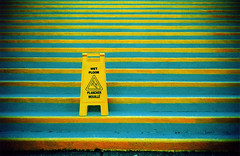
When I first signed up for Spoonflower and resolved to try it, I became frozen by the limitless potential. (What to do? Oh, what to dooo?) Sound familiar?
I explored what others were doing, and I hunted through all the contests on their blog (quite addictive, if you like voting each week on a favourite fabric design!)
It seemed that there were so many possibilities:
- Should I use it to print large swatches of my drawings onto fabric?
- To print computer-generated ideas?
- Or to transfer my existing (black and white) drawings directly onto fabric in quantities and width of yardage that it just wouldn't be feasible to do on the computer or with a stencil-cut screenprinting process? (If you were around last year, you may remember the glee and enthusiasm about stencils and screenprinting).
I sat down and thought about it, and I decided that the only way to go forward was to do a test. I like telling myself that spending money via Paypal is a test. It makes it feel so noble and elevated.
What I was testing with this batch of fabrics was the colour matching and the effect of different sort of designs. I chose three designs: one with a strong drawn black outline (the teapot), which I had coloured on the computer. The other two were scanned versions of my farmyard stencils, which started to look like a lot of fun when I repeated motifs and played with the placement.
Repeats
It took quite a while, fiddling about with the file to find the best proportions for a repeat (white space on one side of the image turns out to repeat across the fabric). Well, yes, of course it does -- but I found that the repeat was not quite what I expected, and half the fun of the process was tinkering about to get it settled so that I liked what I saw. So, for the folksy village fabric below, in the end I had a long, thin file, with each element in a line, staggered, and lots of white space to one side. When it repeats, it just looks like openly-spaced images across the fabric breadth. Hmm.
I had a small sample of the flying birds print, from a stencil. This one wasn't fancy: just one element, repeated across the fabric in a half-step format. I mucked about with the scale, and what I have got is small birds, perfect for button covering, badges and brooches, or for applique. I only ordered a swatch.

Colours
I had done some reading, and I was forewarned that the colours will be less intense on the fabric than on-screen, and also that the reds have a tendency to shift. I pumped up the colours on all of the designs, and I'm glad I did: the teapot fabric design on-screen is quite strong, but in real life it's lovely and soft, without the colours being flat. Big tick in the box for that one!

The village fabric, below, originally was designed with red, blue and green -- but the fabric turned out a very fine orange, blue and green in real life! Initially startled, I have come to rather like it. (Even if the apples do look a little poisonous.)
If I were serious about this, which I'm not (yet), I would get a colour chart printed, with its number references on each square of colour, so that by formatting my final artwork by colour I would have a real, live piece of fabric to match it against. -And I'd know what I'm getting.

There's quite a lot of discussion about this online, and I found it useful, even if the colour calibration of the machines themselves at Spoonflower is subject to change. There's some excellent resources on the Spoonflower blog's FAQs pages.
The verdict?
I quite enjoyed the slight uncertainty about what I would get. I sure ripped into that package when it arrived, a mere 7 days later! I wasn't investing in a lot of fabric or expecting to match it to existing projects or ideas, and so a certain degree of colour shift was fine by me.
As for designs? I feel that the strong outline of the drawings works best. No point translating one fabric printing medium (stencil) into production: better to play with drawings, colour them on-screen, pump up those colours, and take the risk.
I'm working on my next batch of designs as we speak... Surprised?















